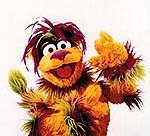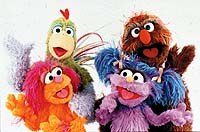CTW is bringing Sesame Street to children all over the world by using a variety of techniques, including local co-productions. Karen Raugust explains how this cultural sensitivity keeps the learning coming.

Sesame Street, Children's Television Workshop's 30-year-old preschool television series, has been broadcast in more than 140 countries over the last three decades. Sixty-eight nations currently air one of various versions of the show; some carry the American original, others a prepackaged half-hour called Open Sesame and some a unique coproduction created for local tastes. Sesame Street consists primarily of live-action studio street scenes, interspersed with freestanding vignettes; a few of the latter are animated but most feature Jim Henson's Muppets. Still, a look at CTW's international distribution strategy is illuminating for animation houses and live-action producers alike.

The U.S. version of Sesame Street airs in Australia, where it has been on for nearly 30 years, and the United Kingdom, where it debuted in 1983. English-language broadcasters in the Middle East, Africa and Asia also carry the show. It has been on the air in Japan since 1971 -- becoming the longest-running U.S. TV series there -- attracting an older audience that wants to learn English. A year ago, Japanese network NHK began running a dubbed version of the show (the first time the American version has been dubbed); viewers can switch tracks from English to Japanese by pushing a button on the remote.
Broadcasters in 29 countries from Afghanistan to Zambia carry Open Sesame, a pre-packaged half-hour culled from the best of the Sesame Street library. It includes freestanding segments from Sesame Street, but not the live-action street scenes, and is dubbed into the local language. Some countries, such as Finland, air a customized version featuring new opens and closes and/or original material starring native children. A new CTW initiative, Sesame English, is a co-venture with publisher Berlitz. It will teach English via 52 15-minute video segments (which also will be sold for broadcast), using a combination of newly created vignettes and repurposed material from the Sesame Street library. Henson created a new Muppet named Tingo for the project, which will also contain a print component.

International Co-Productions
Producers in 19 countries around the world have worked with CTW to create local versions of Sesame Street. All co-productions are 30 minutes in length (the U.S. version runs an hour), with the exception of a 15-minute version in The Netherlands. They feature street scenes reflecting indigenous culture -- in Norway it's a train station instead of a street -- and star a local cast. Co-production partners select from the existing library of freestanding segments, which are dubbed into the local language.
Each co-production incorporates unique Muppets, which interact with the human characters during studio street scenes. The Muppets from the U.S. Sesame Street -- Big Bird, Elmo, Bert & Ernie, Grover and others -- appear in the freestanding inserts but not usually on the street; an exception is China, where the first new Big Bird ever was trained by the original puppeteer. CTW's first international co-production, Sesamstrasse, premiered in 1973 on German network NDR. Other local European versions of Sesame Street include Barrio Sesamo, which launched on Spain's TVE in 1975 and airs in the Castilian and Catalan languages, and The Netherlands' Sesamstraat, which was introduced on NOS in 1976 and was featured on 15 million postage stamps in honor of its 20th anniversary. Norway's Sesam Stasjon premiered on NRK in 1989. In 1996, two new versions debuted, Ulitsa Sesam on Russia's NTV and ORT networks and Ulica Sezamkowa on Polish TV.
In North America, an early co-production was Mexico's Plaza Sesamo, which first appeared on Televisa in 1975 and is distributed throughout the Latin countries. In Canada, the U.S. version of Sesame Street aired on both CBC and TV Ontario for 20 years, with 20 minutes of the original taken out and replaced with Canadian content. Two years ago, Canada created Sesame Park, a co-production that features segments in French, and Canadian Muppets, such as a bear and a beaver.

In 1998, a Chinese co-production, Zhima Jie, premiered on Shanghai Television; a second season of 65 half-hours is in the works. Another new venture, one of the most ambitious yet, is a joint Israeli/Palestinian effort called Rechov Sumsum/Shara'a Simsim, introduced in April 1999 on Israel Educational Television and Al-Quds Educational Television. The 60-episode series includes two separate street scenes, one for each culture, each with its own Muppets and actors. Several crossover segments, where Muppets and human characters from each street visit each other, are incorporated into each show to depict cultural similarities and cross-cultural friendships.

Coming up is an Egyptian Sesame Street with co-production partner Karma Productions, planned for a December 1999 debut. In South Africa, a series premiering in mid-2000 will mark the first time CTW has incorporated radio and community outreach into a co-production launch. "Radio is a much broader medium in South Africa than TV," says Steve Miller, CTW's group vice president of international television and licensing. He believes radio and outreach materials will be an effective way to reach settlement and rural inhabitants, many of whom lack access to television, and notes that the model may be used in other weak television markets. "We're developing a template," Miller says. South African co-production partners are Kwasukasukela for television and Vuleka Productions for radio. Miller lists a number of criteria that come into play when deciding which countries to target for local versions of Sesame Street. "First, we have to find co-production partners that are driven by the same goals as we are here at CTW," he says. "As a nonprofit organization, we look for the biggest opportunities to expand our mission, which is to teach." From a marketing standpoint, CTW also seeks markets that offer the best opportunities to build the Sesame Street brand.
Marketing Support
In each market, CTW supports its educational mission and its brand not only with television, but with book and magazine publishing, home video, licensing, promotions and theme parks. "We look for the best opportunities to extend the reach and power of Sesame Street off the screen," says Miller. "Publishing, along with home video, is a very important foundation." CTW has its own book imprint with U.S. publisher Random House. In each country where Sesame Street, a co-production or Open Sesame airs, a combination of Random House and local titles are available. CTW also publishes six magazines in the U.S., including Sesame Street Magazine, Sesame Street Parents, Padres de Sasame Street (for Hispanic-American parents), Kid City and Contact Kids; some Sesame Street magazines are distributed in international markets as well.

Licensing also strengthens the Sesame Street brand around the world. CTW's licensing strategy is similar from one market to another, varying mostly in scope. "It differs in terms of what the market can bear and how developed licensing is," Miller says. If consumers do not accept licensed products as readily as in the U.S. or other mature licensing markets, then CTW tests the waters slowly. The majority of products in each market depict the U.S.-origin Muppets known worldwide, although some items feature characters specific to that country. Merchandise such as apparel and paper goods can be produced cost-effectively by local manufacturers for just one market and can feature local characters. Others, such as toys, require heavy product investment; licensees, therefore, want to distribute in as many countries as possible and incorporate globally recognized characters that allow them to do so.
All told, CTW has authorized more than 10,000 items worldwide through 300 licensing agreements. The organization has allied with a number of promotional partners as well, including Nestlé for Ulitsa Sezam in Russia and General Electric for Zhima Jie in China. Meanwhile, Sesame Street characters star at three theme parks, Anheuser-Busch's Sesame Place in Pennsylvania, eight-year-old Tokyo Sesame Place and Parque Plaza Sesamo in Monterrey, Mexico. A fourth, Vila Sesame, is in the works for Brazil. Other CTW Animated Programming In addition to Sesame Street, Children's Television Workshop produces other programming for international distribution, some of which is animated or features significant animation components. One example is Big Bag, a preschool series that airs on The Cartoon Network in the U.S. Like Sesame Street, the series takes place on a studio set with Muppet and human characters; the live scenes are interspersed with short animated segments in a variety of styles. Broadcasters in 53 countries air Big Bag, while TV2 in Denmark, Icelandic National Broadcasting in Iceland, Wharf Cable and Asia Television in Hong Kong and Fundacao Roberto Marinho in Brazil carry one or more of the animated shorts -- in which recurring characters appear -- as standalone series. Following Sesame Street's co-production model, broadcasters in two countries have created local versions of Big Bag, with unique Muppets, actors and content. The French version, Sacatruc, which premiered in 1997 on Canal J, features more arts and crafts content than the U.S. version and contains other elements specific to French culture. "Sacatruc is a French show," Miller says. The British version of Big Bag was introduced on ITV in 1998.

Another CTW series, co-produced with Columbia TriStar Television, is Dragon Tales, an animated preschool program that launched in September 1999 on PBS's Ready To Learn service with 40 half-hours. Each episode is comprised of two 12-minute segments with musical interstitials, a flexible structure that Miller believes will enhance international sales. The series, which is expected to launch outside the U.S. in January 2000, is about accepting the unknown. Hasbro is on board as the worldwide master toy licensee and CTW plans a full merchandising campaign to back the launch. The Workshop is looking to invest in international programming in the early development stage and expects that some of the co-ventures will premiere internationally before they start in the U.S. One such alliance is with Pepper's Ghost Productions in the U.K., for a series called Tiny Planets. CTW is also planning to create programming specifically for the Internet. Karen Raugust is the author of several books and reports on licensing and entertainment, including The Licensing Business Handbook,International Licensing: A Status Report (both available from EPM Communications, New York) and Merchandise Licensing for the Television Industry (available from Focal Press, Newton, Mass.). She also writes about licensing, animation and other topics for publications including The Hollywood Reporter, Publishers Weekly and Animation Magazine, and acts as a consultant to the licensing and entertainment industries. She is the former Executive Editor of The Licensing Letter.







